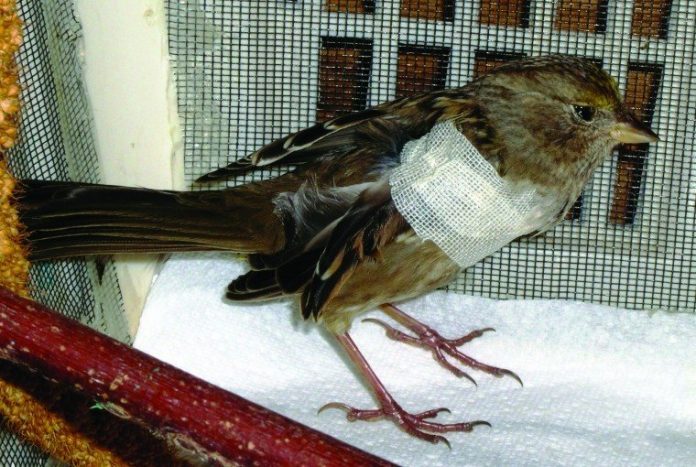Nearly everyone recognizes the changing of the season when tree
leaves turn autumnal red and yellow, or when high school football
games are again being played under Friday night lights, or upon
viewing bright orange pumpkins in the fields all plump and ready
for Thanksgiving pies.
Nearly everyone recognizes the changing of the season when tree leaves turn autumnal red and yellow, or when high school football games are again being played under Friday night lights, or upon viewing bright orange pumpkins in the fields all plump and ready for Thanksgiving pies.
But ardent bird-lovers know fall has arrived in California when they start seeing little golden-crowned sparrows noshing at their backyard feeder again.
Golden-crowned sparrows are migratory – summering and breeding in northwestern Canada and Alaska, then flying south to winter in the warmer Pacific Coast states. So when this immature sparrow injured its wing last month, after being hit twice by cars along a rural road in Morgan Hill, the initial prognosis didn’t appear very good that the bird would again be able to fly well enough for a long-distant journey.
The sparrow’s right wing was badly drooping, but there was a sigh of relief when it was determined that the bone was not fractured. The wing was gently wrapped to provide support and aid healing. The small, fragile bird was difficult to work with, and needed to be handled extremely carefully, both to prevent further injury and to keep it from jumping out of our cupped hands, since it couldn’t be held tightly.
After two weeks with bandaging, the wing was still drooping, but just slightly. The bird was transferred to an outdoor enclosure so it could fly in safety and strengthen its muscles. It will remain in the enclosure for a couple of weeks, then will be released on a crisp, clear morning in the vicinity of where it was found. The juvenile, 6-inch songbird has traces of yellow just beginning to show on its forehead and by the time it’s ready to migrate back to its northern home in the spring, it will be sporting a perky black-striped golden cap.
Golden-crowned sparrows forage on the ground in gardens and fields and are frequent visitors of backyard birdfeeders, joining flocks (called a “reign”) of similar white-crowned sparrows. During the summer, when they’ve gone north again, insects become a major food source, especially for the younger birds.
The golden-crowned sparrow was considered a pest early in the 20th century, because flocks would feed on grass seed, vegetables, berries, flowers and the buds of fruit trees in gardens and cultivated fields. Later research determined that its impact wasn’t as serious as was originally thought, and the bird is no longer regarded as a pest. Still, their fondness for buds and flowers sometimes doesn’t make them welcome to some gardeners. They can take a heavy toll on flowering annuals, especially in California where many are planted in the autumn.
But for those bird-and-nature-lovers who want to thrill to the song of the sparrow – which is a three-note whistle, often described as “oh-dear-me” (Alaskan gold miners called this bird Weary Willie, because its call sounded like “I’m so weary”) – you can attract these enchanting creatures by offering quality bird seed (with millet and sunflower seeds) in feeders on the ground and near trees and bushes to provide shelter from predators, i.e., cats.
The eminent American naturalist, Henry David Thoreau, spoke glowingly of these little birds: “I once had a sparrow alight upon my shoulder for a moment, while I was hoeing in a village garden, and I felt that I was more distinguished by that circumstance than I should have been by any epaulet I could have worn.”












